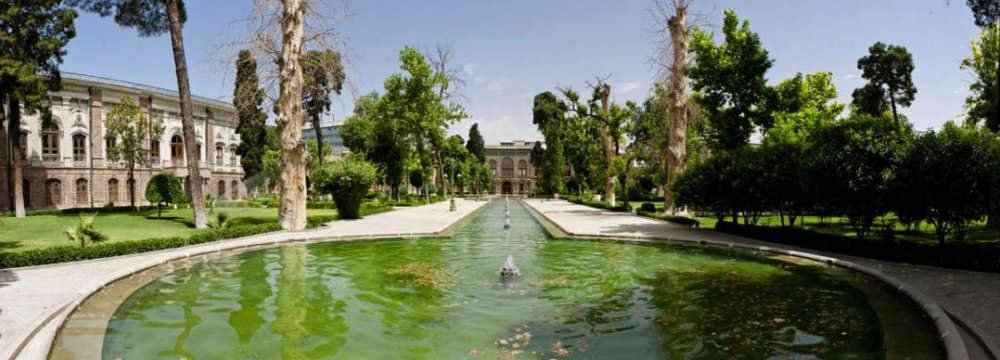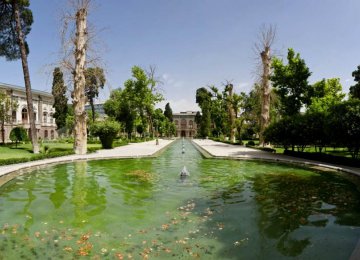The only remnant of Tehran’s historical citadel is the Golestan Palace. It belongs to a group of erstwhile royal buildings that were once enclosed within large thatched walls, according to Iran Review.
The historical citadel of Tehran was originally built during the time of Shah Tahmasb I of Safavid dynasty (1501 - 1722). It was reconstructed at the time of Karim Khan (1705 - 1779) of Zand dynasty.
It was later turned into a residence and court for the former ruling powers; the complex occupying over a third of the citadel. Typical of traditional Iranian houses, the building has interior and exterior quarters (‘andaruni’ and ‘biruni’).
The exterior quarters consisted of the administrative section of the royal court and a square shaped garden known as Golestan (rose garden).
The interior quarters were located to the east of the administrative section, and north of Golestan. They were later destroyed and replaced by the ministry of economic affairs and finance.
During modern times, Golestan Palace was used to host formal receptions. Between 1925 and 1945, a large part of Golestan Palace was destroyed by the order of Reza Shah.
In its present state, Golestan Palace is the result of 400 years of reconstruction and renovations. Each of its buildings has a unique history.
Marble Throne Building
While Golestan Palace was used as the court’s interior quarters for private meetings and nocturnal feasts, the Marble Throne Building was used for formal state receptions.
Architecture, paintings, stone carvings, tile work, stucco, mirror work, enameling, wood work, and lattice work have created unforgettable masterpieces in the building architecture and facade.
People from various walks of life were received in the building during official ceremonies. In 1806, stone carvers from Isfahan were ordered to make a throne from the famous marble of Yazd. It was placed in the middle of the Iwan or rectangular hall. It appears that the Iwan, older than the other parts of the historical citadel, was built during the reign of Karim Khan who laid the foundation of the Marble Throne Building in 1759.
The main hall of the building is supported by two twisted marble columns with muqarnas, a type of corbel employed as a decorative device in Persian architecture. These eight-meter tall columns were reputedly taken in 1771 from Qasr-Vakil in Shiraz. The carved yellow marble dados decorated with flowers, parrots, and eagles, are said to have the same origin.
The walls and ceiling of the hall are decorated with mirror-work mosaics, colored lattice windows, marble carvings, and oil paintings.
The marble throne within the hall was designed by court painter Mirza Baba Shirazi and built by court mason Mohammad Ebrahim Esfehani. It is composed of 65 fine pieces of yellow marble from the province of Yazd. The seat is carried on the shoulders of angels and demons. Its steps are adorned with dragons and lions.
Wind Tower Building
The Wind Tower Building is located in the southern wing of Golestan Garden. Built in the late 18th century, it was dramatically modified as a result of major renovations in 1853.
Each corner of the building bears a tall wind tower covered with blue, yellow and black glazed tiles and topped with a golden cupola. The current of cool air, coming through the towers, cools the summer chamber, hall and rooms.
In the basement of the building there is a pond which cooled the air currents caught by the wind towers. The basement is now a photo gallery (‘aks-khane’).
Reception Hall-Museum
New buildings were constructed on the northwestern wing of Golestan Palace next to Ivory Hall. The buildings included lobby, the Mirror Hall and museum hall.
Construction of the museum hall began in 1870 and ended in 1873. However it was not used until 1878.
Though the hall was intended to become a museum from the very beginning, it became the venue of official court receptions and was thus named the Reception Hall, because the famous Peacock Throne was moved from the Mirror Hall to the museum.
In 1966, the summer chamber in the basement was divided into two sections. The eastern part, called Special Hall, is dedicated to fine arts. The western part, known as the Art Gallery, is the venue of an exhibition displaying paintings.
Karim Khan Veranda
In the northeastern corner of the Golestan Palace, next to the Reception Hall, there is a building in the form of a veranda. At its center is a fountain, where water once flowed from a subterranean steam (Qanat).
Named after Karim Khan, the building was part of Karim Khan’s residence. Though much of its splendor and beauty are lost, the artistic legacy can still be observed in the intricate work.
Diamond Hall
Diamond Hall is located in the southern wing of Golestan Palace, near the Wind Tower Building. It is called “Diamond Hall”, because of its glittering mirror works.
There are 3 small Iwans on the 3 sides of the main hall; each is elevated and ornamented with mirror muqarnas and stucco carvings. The north side of the hall is decorated with large wooden lattice windows with colored glasses known in Persian as orosi.
White Palace
A new palace was constructed in the late 19th century, in the south-western wing of the Golestan Palace as a depository for the Ottoman Sultan Abd-ol-Hamid’s gifts.
The white building, with its 18th century European style stucco, was named ‘White’ for the color of the stuccos and the white marble stones in its hall and staircase.
The building became an anthropology museum in 1968, displaying some of the most ancient artifacts to be found in Iran.
Sun Building (Shams-ol-Emareh)
Shams-ol-Emareh is the finest edifice on the eastern wing of Golestan Palace. It is the tallest building in the Golestan Palace and fuses Persian and European architecture into a five-story structure with two flanking towers. The exterior of the building is decorated with polychrome tiles and wooden lattice windows with colored glasses.
On the first floor, the main hall of the building faces west to the garden. The hall and its adjoining rooms are decorated with mirror-work mosaics and carved stucco.





